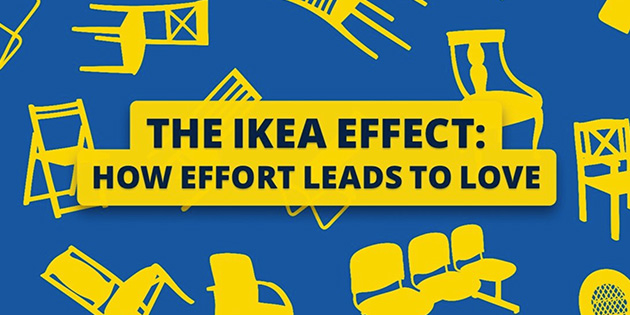What is the IKEA Effect?
Norton et al (2011)[1] coined the ‘IKEA Effect’ as the title of their research paper, which detailed the value consumers placed on products they partially created. They found that subjects who were asked to build IKEA furniture, origami animals and Lego, placed a disproportionately high value on the end products.
Their work built on Shapiro (2004)[2], who wrote of efforts by General Mills in the 1950’s to sell more Betty Crocker instant cake mixes. Focus groups identified that replacing powdered eggs in the cake mix with the requirement to add fresh eggs would better value the labour and skill of the baker.
They successfully managed to boost sales, ostensibly as a result of the cook feeling they were contributing to the creation in a more meaningful way.
While some writers dispute the truth of this story, (Mortimer et al (2019)[3] indicate at least two other companies had already introduced fresh eggs into the recipe prior to General Mills), the results indicate a psychological sense of ownership where the consumer has contributed to the creation of the product.
Norton et al also found that successful completion is an essential component for the link between labour and liking to emerge, and that the increase in willingness-to-pay for hedonic products may arise in part due to the social utility offered by assembling these products.
Where can we see the IKEA Effect in action?
While identifying the IKEA effect within loyalty programs is somewhat challenging because it is generally more relevant for products than programs, it nevertheless plays a significant role in building member engagement.
This includes:
- Digital subscriptions that allow for the creation of playlists which can be fully customised and shared, or the creation of your personalised watch lists (e.g. Spotify and Netflix respectively).
- Quick service restaurants which allow for the design of burgers (e.g. McDonald’s).
- Home meal kit companies, where consumers can personalise the type of food box, meals, etc (e.g. Marley Spoon).
The current IKEA Family program
The IKEA Family program is a fairly standardised member benefits design, all of which are provided by IKEA (vs a design where a 3rd party may provide some or all of the benefits). Here is the entire benefit summary.
- $10 voucher on joining.
- Opportunity to earn a $10 voucher per quarter by spending a minimum of $100 per quarter.
- Member priced products.
- Member priced meals.
- Exclusive workshops and events.
- Charity donation.
- Pre-bookings in Småland.
- Digital receipts.
- Free replacement of damaged products (due to transportation or assembly) within 14 days.
The opportunity for the IKEA Family program
Thinking back to the ‘IKEA Effect’ and the whole concept of giving consumers the chance to contribute, therefore making the effort more meaningful, I feel there’s a lost opportunity.
Imagine if members were given an option to customise IKEA Family benefits that were best suited to them and hypothetically asked to choose four of out of the available nine.
Some members might preference the member priced meals over pre-bookings in Småland, while others might prefer the opportunity to access exclusive workshops and events over the ability to donate to charity.
Alternatively, what if members were given an opportunity to provide input into additional member benefits? Who better to ask than your customers? New benefits could subsequently be introduced every now and then based on member input and the members who suggested them could be recognised. I can’t think of a better way to evolve the program with meaningful benefits, whilst at the same time keeping it fresh and differentiated.
Both ideas would make the member feel like they’ve contributed in a meaningful way. The member, therefore, will be much more likely to place a higher value on their membership because they’ve had some input. In turn, this will translate into higher engagement.
Even though the ‘IKEA Effect’ typically applies to products, I believe there’s a great opportunity here for IKEA to capitalise on the concept and apply the thinking to IKEA Family, to really elevate their program to the next level.
[1] Norton, M. I., Mochon, D., & Ariely, D. (2012). The IKEA effect: When labor leads to love. Journal of Consumer Psychology, 22, 453-460.
[2] Shapiro, Laura (2004), Something from the Oven: Reinventing Dinner in 1950s America, New York: Viking.
[3] Mortimer, G., Mathmann, F. and Grimmer, L. ‘How the “Ikea effect” explains today’s startups,’ Fast Company, January, 2019


